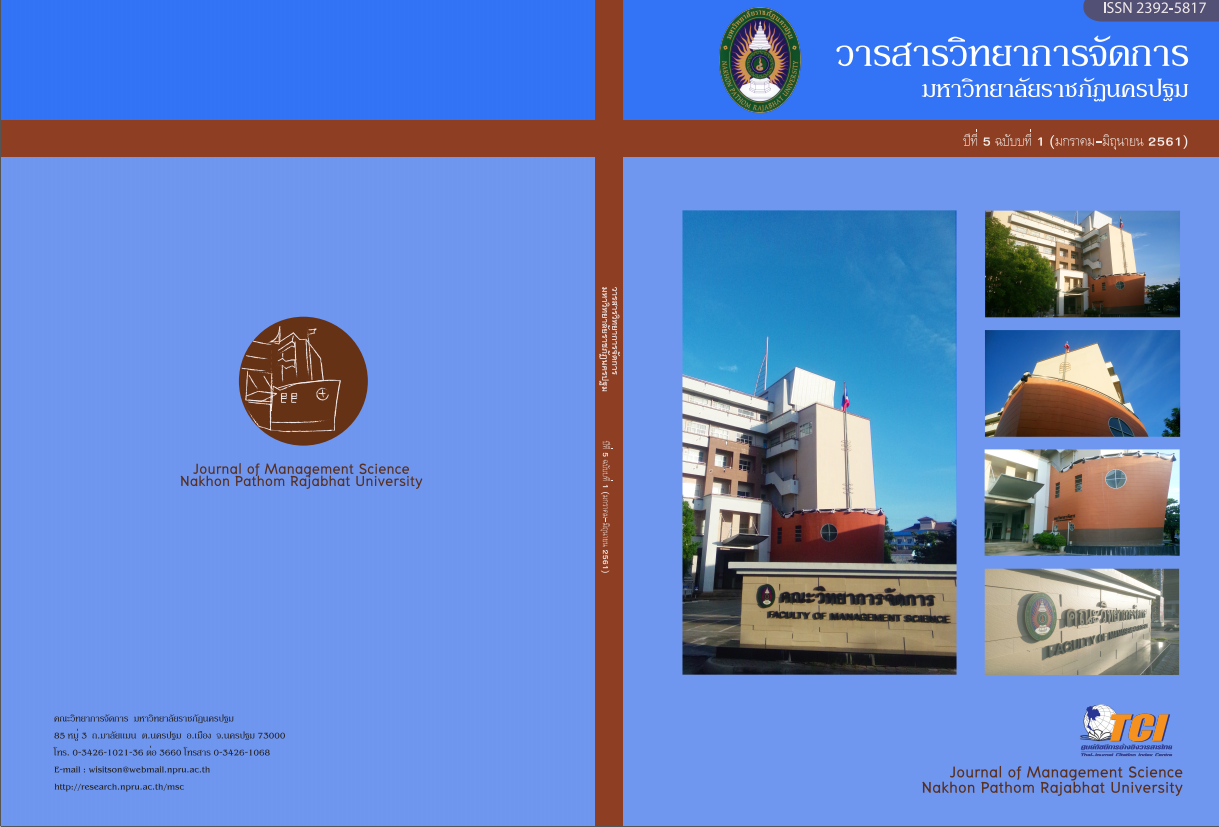Guidelines for engagement and good membership behavior of personnel organizations in Metta Pracharak Hospital (WatRaiKhing)
Main Article Content
Abstract
The purposes of this research were to: 1) study the level of organizational commitment and good citizenship behavior of personnel; 2) compare the level of organizational commitment and good citizenship behavior of personnel, as classified by personal factors; 3) study the factors affecting organizational commitment and good citizenship behavior of personnel; and 4) study the guideline for building organizational commitment and good citizenship behavior of personnel. The research sample was 234 personnel of all types derived by proportional stratified random sampling, and 6 key informants derived by purposive sampling. The research instruments were a questionnaires and an in-depth interview constructed by the researcher. Data were analyzed with frequency, percentage, mean, standard deviation, independent t-test, one-way ANOVA, correlation analysis, stepwise multiple regression and content analysis.
The research results were as follows:
1. The organizational commitment was at a moderate level (3.27), and the good citizenship behavior was at a high level (3.68)
2. The personnel with differences in gender and type of position had different level of organizational commitment and good citizenship behavior with statistical significance of .05.
3. All aspects of organizational commitment, which were basic needs, administrative support, relationship, and career advancement, affected organizational commitment building. The organizational commitment in aspects of relationship and career advancement affected good citizenship behavior.
4. The guidelines for building organizational commitment and good citizenship behavior of personnel were: in factors affecting organizational commitment, organizations should encourage, support and develop career advancement by giving opportunities for personnel to participate in training, seminars or study visit. The organization should organize meeting between executives and personnel to inform policy and receive personnel’s suggestions. Therefore, the meeting develops a good communication, recognizes problems and finds effective solutions about compensation and benefits. In organizational commitment building, organizations should consider about fair and equitable compensation and benefits. The performance appraisal process should be fair and transparent. Organization values and good organizational culture should be instilled. In good citizenship behavior aspect, organizations should build personnel’s awareness about living according to royal principles of sufficiency economy philosophy. The organization should promote job security. The executives should regularly monitor worksite to recognize problems and find solution guidelines systematically, and build good relationship among subordinates.
Article history : Received 8 August 2017
Revised 28 September 2017
Accepted 1 October 2017
SIMILARITY INDEX = 0.00
Article Details
The views and opinions of the article appearing in this journal are those of the author. It is not considered a view and responsibility of the editorial staff.
References
กฤติน กุลเพ็ง. (2558). การบริหารทรัพยากรมนุษย์ในศตวรรษใหม่. [ออนไลน์]. ค้นเมื่อ 20 กรกฎาคม 2559 จาก https://www. krittin.in.th.
กฤษดา แสวงดี. (2558). เจาะลึกระบบสุขภาพ อีก 10 ปีวิกฤตหนักขาดแคลนพยาบาล. [ออนไลน์]. ค้นเมื่อ 25 กรกฎาคม 2559 จาก https://www. Hfocus.org.
จิดาภา นากา. (2552). ปัจจัยที่มีอิทธิพลต่อความยึดมั่นผูกพันในองค์การของพยาบาลวิชาชีพโรงพยาบาลบำรุงราษฎร์ อินเตอร์เนชันแนล. วิทยานิพนธ์ปริญญาวิทยาศาสตร์มหาบัณฑิต(สาธารณสุขศาสตร์). สาขาวิชาเอกบริหารสาธารณสุขบัณฑิตวิทยาลัย. มหาวิทยาลัยมหิดล.
จิรนันท์ วงษ์ไทยวรรณ. (2551). ความสัมพันธ์ระหว่างความสามารถในการเผชิญและฟันฝ่าอุปสรรค การรับรู้การสนับสนุุนจากองค์การและพฤติกรรมการเป็นสมาชิกที่ดีขององค์การ: กรณีศึกษาพยาบาลวิชาชีพของโรงพยาบาลเอกชนแห่งหนึ่งในจังหวัดนครปฐม. งานวิจัยส่วนบุคคลศิลปศาสตรมหาบัณฑิต. สาขาวิชาจิตวิทยาอุตสาหกรรมและองค์การคณะศิลปศาสตร์. มหาวิทยาลัยธรรมศาสตร์.
เนาวรัตน์ เจริญสุข. (2553). แรงจูงใจและบรรยากาศองค์การที่ส่งผลต่อความยึดมั่นผูกพันต่อองค์การของพยาบาลวิชาชีพ ในโรงพยาบาลชุมชนจังหวัดบุรีรัมย์ประเทศไทย. วิทยานิพนธ์ปริญญาวิทยาศาสตร์มหาบัณฑิต (สาธารณสุขศาสตร์). สาขาวิชาเอกการบริหารโรงพยาบาลบัณฑิตวิทยาลัย. มหาวิทยาลัยมหิดล.
นภาพร ศิริพรกิตติ. (2554). ความผูกพันองค์การและประเภทวัฒนธรรมองค์การของพยาบาลวิชาชีพโรงพยาบาลศิริราช. วิทยานิพนธ์ปริญญาวิทยาศาสตร์มหาบัณฑิต (สาธารณสุขศาสตร์). สาขาวิชาเอกการบริหารโรงพยาบาลบัณฑิตวิทยาลัย. มหาวิทยาลัยมหิดล.
เบญจมาภร อาษากิจ. (2556). ปัจจัยที่มีอิทธิพลต่อความยึดมั่นผูกพันองค์การของพยาบาลวิชาชีพโรงพยาบาลมหาวิทยาลัยไทยแห่งหนึ่ง. วิทยานิพนธ์ปริญญาวิทยาศาสตร์มหาบัณฑิต(สาธารณสุขศาสตร์). สาขาวิชาเอกบริหารสาธารณสุขบัณฑิตวิทยาลัย. มหาวิทยาลัยมหิดล.
ปาริชาติ ขำเรือง. (2554). ความผูกพันต่อองค์การของอาจารย์มหาวิทยาลัยราชภัฏ. ดุษฎีนิพนธ์ปริญญาปรัชญาดุษฎีบัณฑิต. สาขาวิชาการจัดการบัณฑิตวิทยาลัย. มหาวิทยาลัยสยาม.
พัฒน์นรี สมานวงศ์ไทย. (2552). ความยึดมั่นผูกพันต่อองค์การของพยาบาลวิชาชีพ โรงพยาบาลเมตตาประชารักษ์ (วัดไร่ขิง). สารนิพนธ์ปริญญารัฐประศาสนศาสตรมหาบัณฑิต. บัณฑิตวิทยาลัย. มหาวิทยาลัยบ้านสมเด็จเจ้าพระยา.
โรงพยาบาลเมตตาประชารักษ์ (วัดไร่ขิง). (2559). จำนวนบุคลากรของโรงพยาบาล.[ออนไลน์]. ค้นเมื่อ 1 พฤษภาคม 2559 จาก https://www.metta.go.th/hrm/thefences/index.html.
สมจิตร จันทร์เพ็ญ. (2557). ความสัมพันธ์ระหว่างความยุติธรรมในองค์การ การแลกเปลี่ยนระหว่างหัวหน้าหอผู้ป่วยกับ พยาบาลประจำการกับพฤติกรรมการเป็นสมาชิกขององค์การของพยาบาลประจำการ โรงพยาบาลสังกัดสำนักการแพทย์ กรุงเทพมหานคร.สารนิพนธ์ปริญญาศิลปศาสตร์มหาบัณฑิต (การบริหารพัฒนาสังคม). คณะพัฒนาสังคมและสิ่งแวดล้อม บัณฑิตวิทยาลัย. สถาบันบัณฑิตพัฒนบริหารศาสตร์.
อารีรัตน์ รัตนสุภาชัย. (2552). บรรยากาศองค์การกับความผูกพันต่อองค์การ: กรณีศึกษาโรงพยาบาลสันกำแพง. สารนิพนธ์ปริญญารัฐประศาสนศาสตรมหาบัณฑิต. บัณฑิตวิทยาลัย. มหาวิทยาลัยเชียงใหม่.
Coffman, C. & GonzaleZ-Molina, G.(2002). Follow This Path : How the World’s Greatest Organizations Drive Growth by Unleashing Human Capital. New York : Warner.
Gallup Consulting. (2010). Employee engagement : What’s Your Engagement Ratio? Retrieved January 26, 2017, from https://www.gallup.com/consulting/121535/Employee-Engagement- Overview-Brochure.aspx.
Institute for Employment Studies (IES). (2004). Employee Engagement. Retrieved January 30, 2017, from https://www. employment-studies.co.uk/ news/ 129 theme.php.
Krejcie, R. V. & Morgan, D.W. (1970). Determining sample size for research activities. Educational & Psycological Measurement : 30 (3). 607-610.
Organ, D. W. and Bateman, T. S. (1991). Organizational Behavior. (4th ed.), Boston : Irwin, Inc.
Sheldon, M. (1971).Investments and Involvement as Mechanisms Producing Commitment to Organization. Administrative Sciences Quarterly;16 (6) : 143-150.


